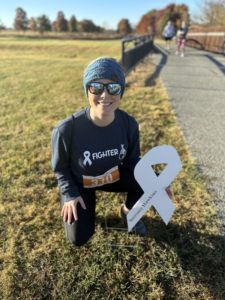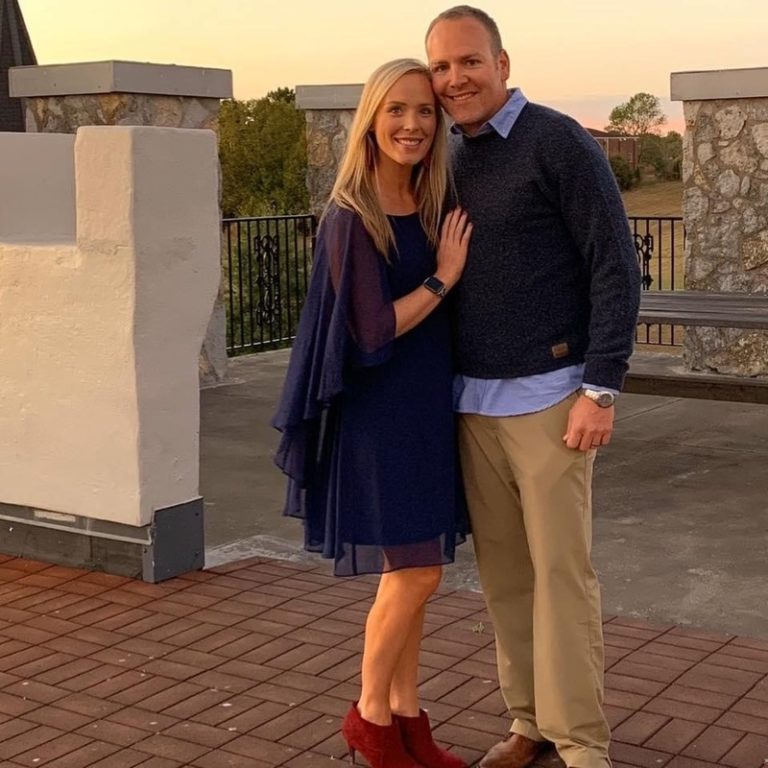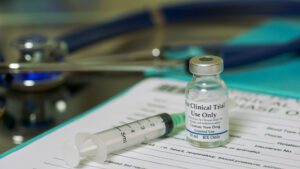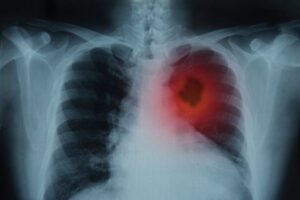On the one-year anniversary of her RET+ non-small cell lung cancer (NSCLC) diagnosis, 37-year-old Brittany Hawkins had spent some time reflecting on her journey.
When she was just seventeen years old, Brittany had lost her mother to pancreatic cancer. So, when Brittany received her own cancer diagnosis, it felt like deja vu. However, this time around, it was difficult to know what to feel, with so much uncertainty.

One year after her diagnosis, Brittany was not only surviving, but thriving. With treatment, a targeted therapy called GAVRETO, her lymphatic system cleared up. The spots on her bones became sclerotic. And the “mother ship” (the main tumor in her lung) shrunk from the size of a lemon to the size of a raisin. Being where she is at is nothing short of miraculous.
She logged onto her social media account and typed:
1 year. It’s been 365 days since the word cancer was added to my medical history. I’m 25lbs heavier. My doctor says I needed it. My dad says it’s my fighting weight. I’ve learned to take the time. I don’t worry about being late anymore. Life is not a list of things to do, it’s a collection of people to love. I try all the new things. Food. Drinks. Adventures. The truth is we’re all on a clock and life is meant to be lived. And as I lay my head down tonight, my heart is full. I’m blessed beyond measure. My hope is secure. And I rest praying I get to fight another day.
Recently, Brittany and I sat down to discuss her journey, the importance of biomarker testing, how to advocate for yourself, and advice for people who are newly diagnosed.
RET+ Non-Small Cell Lung Cancer (RET+ NSCLC)
The American Cancer Society estimates that 80-85% of lung cancer is considered to be non-small cell lung cancer (NSCLC). There are three main forms of NSCLC: adenocarcinoma, large cell carcinoma, and squamous cell carcinoma. RET-positive (RET+) NSCLC makes up just 1-2% of NSCLC cases and is normally found in adenocarcinoma. Those with RET+ NSCLC are often younger than other lung cancer patients and are less likely to have a history of smoking. According to the American Lung Association, there are two types of RET genetic errors which can cause cancer. Point mutations are most commonly found in medullary thyroid cancer. For NSCLC, the cause may be a RET rearrangement or gene fusion:
That is when a piece of DNA joins with another gene and creates a fusion. This fusion leads to uncontrolled cell growth and cancer.
Symptoms of NSCLC can (but do not always) include:
- A cough that doesn’t go away or worsens over time
- Difficulty breathing
- Wheezing
- Fatigue
- Difficulty swallowing
- Swelling in the face or veins of the neck
- Hoarseness
- Chest pain or pressure
- Coughing up blood
- Appetite loss
- Unintended weight loss
Brittany’s Story
In April 2021, Brittany began experiencing a troublesome cough. The cough was disruptive, often keeping her up at night and interrupting her sleep. It seemed to worsen when she laid down. Of course, April 2021 was still at the height of the COVID-19 pandemic, so Brittany knew that she needed to get checked out just to be safe. This marked the start of a journey that would change her life.
At first, Brittany visited her primary care physician and was diagnosed with a viral infection. Although it didn’t quite run its course, Brittany was placed on a round of steroids to help healing and reduce inflammation. She explains:
We live in Kentucky and have something called ‘the Kentucky crud.’ When the seasons change around here, people get this dry, hacking cough. So, we kind of just brushed off the fact that I couldn’t kick this cough. After all, I was an extremely healthy 36-year-old, so nobody thought anything of it.
Still, Brittany followed up with her doctor every four weeks just in case. As weeks went by, she not only wasn’t improving, but actually found her symptoms were worsening:
I had difficulty climbing the stairs or holding my breath to wash my face. I couldn’t stand to sing at church. The doctors also diagnosed, at the time, ocular migraines, where I would lose vision or it would get wavy in my peripherals. But we didn’t really put anything together or link these to the cough. I was under a lot of stress at the time so we assumed these symptoms were stress-related.
Out of an abundance of caution, her doctor decided to do some additional testing, to include an X-ray. At the time, she wasn’t too concerned about it – until the doctor called in June 2021 and told Brittany that her X-ray was a little “funky.” Because of this, her doctor recommended that she see a pulmonologist. However, since the local pulmonology group is affiliated with the statewide hospital system, there was a three-month wait to visit the pulmonologist.
Reflecting back on that moment in time and where her career had led her, it’s clear that the stars had aligned in her favor. When Brittany left high school, she began an administrative position within the healthcare realm while taking college courses. Since then, she has transitioned into a professional role as a systems trainer for one of the state-wide hospital systems. It just so happened that one of the members on her team at the time came from the pulmonology office and she would play such a critical role in her story. Brittany explains:
She told me that she was tired of my cough (jokingly, of course). But she managed to get me in to see the pulmonologist sooner. And that was so important because I credit that in starting the journey that eventually helped me meet the doctor who saved my life.
Brittany’s NSCLC Diagnosis
On July 15, 2021, Brittany visited the pulmonologist. By that time, she was having extreme shortness of breath, struggling to walk from the office waiting room to the other room. Her pulmonologist assumed it was some sort of nasty infection and referred her for a CT scan. Fortunately, because of Brittany’s affiliations, she was able to get in for a scan the very next day. Within an hour of the scan, the pulmonologist called and told Brittany that she had a mycobacterium avium complex (MAC) infection. Little did she know how quickly things would escalate. She shares:
He told me that I’d probably have to be on antibiotics for up to five years, but that we’d get it cleared up. At the time, it sounded like the worst thing ever. They wanted to do a bronchoscopy the next week just to be sure. But on Monday I arrived at work & I couldn’t say hello. My words were jumbled. I tried to make a joke about having a ‘mini stroke,’ but it turns out that I had a real stroke that day. My ‘ocular migraines’ had been mini strokes. I went to the hospital and they were trying to figure out why a healthy 36-year-old would have a stroke.
Since she was already in the hospital, her pulmonologist decided to perform the bronchoscopy. Two short days later, he came back to Brittany’s room to deliver news she would never forget. She recalls:
He told me that he didn’t know how to tell me the news and asked if he could hug me. And after he hugged me, he told me that I had late-stage lung cancer. I was in shock. I’ve never been a smoker. When I was younger, my parents told me I was allergic to smoke so I never even tried smoking.
Her pulmonologist referred her to an oncologist in Louisville named Dr. Adam Lye. At this point, Brittany was experiencing some severe health impacts. She explains:
To tell the story now, he says I was a runaway freight train. My lungs looked like a shotgun blast went off inside. I had cancer in my lymphatic system that had spread to the bones and affected the blood. We began an onslaught of testing for the cancer and stroke prevention. I had three more blood clots and blood pooling behind my heart. He wouldn’t tell me this then, but he thought I only had three months to live.
Dr. Lye wanted to understand exactly what was causing this in a seemingly healthy woman in her mid-30s. So, he began testing with a liquid biopsy, but it came back yielding no results. He began treating Brittany with chemotherapy but said that he wasn’t comfortable just writing this off and promised that he would continue to dig.

Eventually, he found the answer they were searching for. After performing a biopsy on a piece of Brittany’s lung and testing it, Dr. Lye discovered that Brittany had the RET+ mutation.
Don’t forget to join us in Part 2, where Brittany discusses RET+ NSCLC, what biomarker testing is (and why it’s important), and how to be your best advocate.







